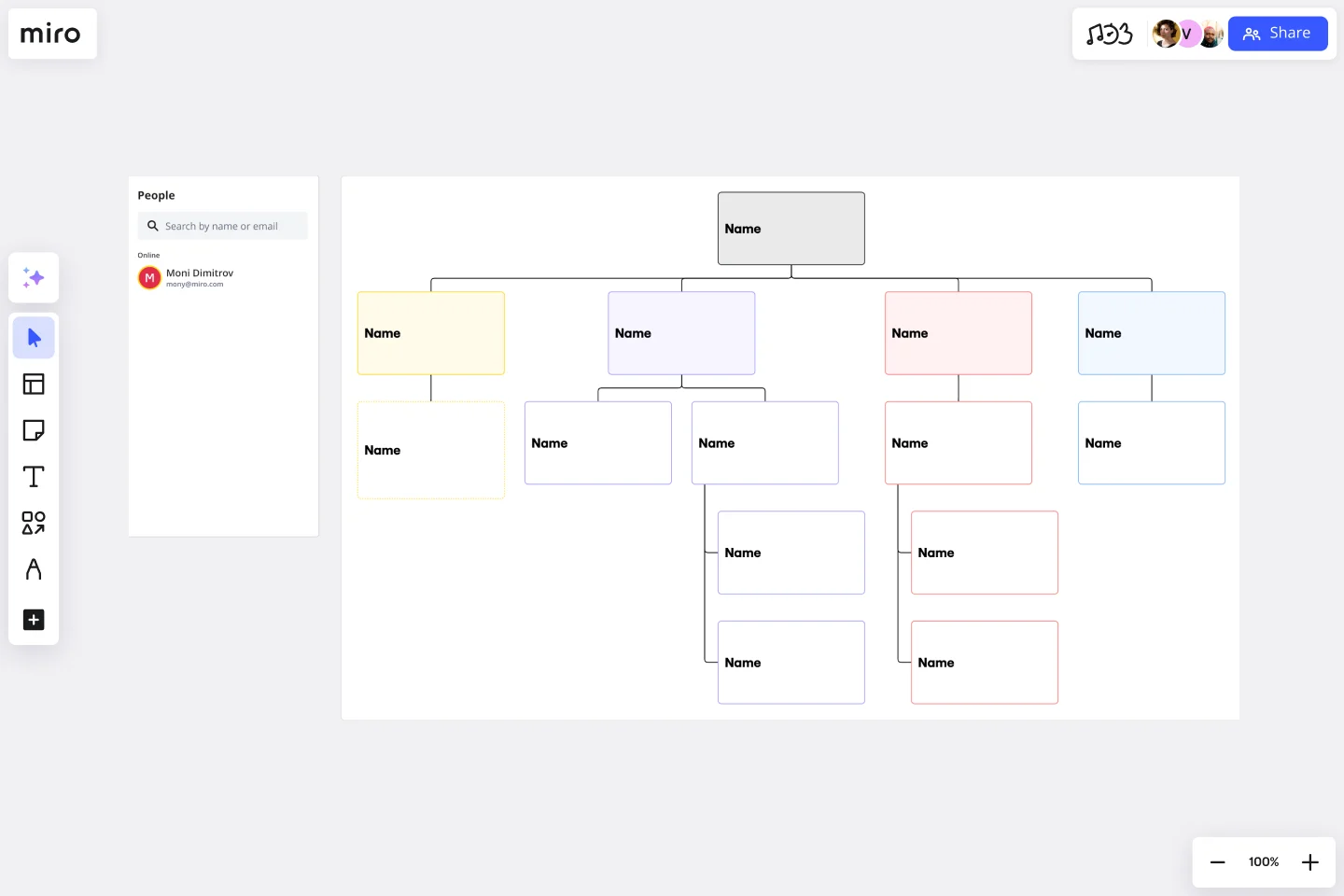Company Organizational Chart
Create a visual guide to the structure of your organization.
About the Company Organizational Chart template
A company organizational chart is a visual guide to how your organization is structured. It will generally reflect the reporting structure (who manages specific teams and people) and can be especially helpful for new employees to refer to as they familiarize themselves with your company.
Why should you use a company organizational chart?
In addition to showing the relations between employees at your company, you can also use a company organizational chart template to represent the structure of different departments or corporate functions inside your business.
When to use a company organizational chart template?
You can use your company organizational chart when planning employees’ career plans, managing HR resources, or any presentation you see fit.
How do you use the company organizational chart template in Miro?
Creating a company organizational chart is easy using Miro! Simply follow these easy steps to create an organizational chart that visually showcases your company structure:
Start with our pre-made company org chart template. Then, customize any elements you’d like, changing the sizes, shapes, and colors. For example, you may want to use colors or shapes to indicate people’s level of authority or department.
Write the names of the people inside your organization, as well as their roles and responsibilities. You can either just leave it in written form or add photos or other images to represent each person visually in your company organizational chart.
Invite your coworkers to collaborate in your company organizational chart template with you. Your company organizational chart can be a living document, and any changes you or your teammates make to the chart will be reflected in real-time.
If you are interested in learning all about organizational charts, and the various types and uses, you can read our comprehensive guide.
What are the four types of organizational structures?
The traditional four types of organizational structures. Functional: C-level is on the top of the structure, followed by senior management, management, etc. Divisional: where product lines and geography organize teams and people. Matrixed: people are organized in teams depending on the project/product they are working on Flat: where hierarchies are little to none and teams self-manage themselves. These are traditional company organization structures, but as we live in a more dynamic and decentralized work environment, those structures have been challenged and disrupted by new agile teams and businesses.
Where can I find a company organizational chart?
You can find a company organizational chart in our Templates Library or Miroverse.
Get started with this template right now.
3-Circle Venn Diagram
Works best for:
Education, Diagrams, Brainstorming
Venn diagrams have been a staple of business meetings and presentations since the 1800s, and there’s a good reason why. Venn diagrams provide a clear, effective way to visually showcase relationships between datasets. They serve as a helpful visual aid in brainstorming sessions, meetings, and presentations. You start by drawing a circle containing one concept, and then draw an overlapping circle containing another concept. In the space where the circles overlap, you can make note of the concepts’ similarities. In the space where they do not, you can make note of their differences.
Collaboration Cosmos Team Charter
Works best for:
Org Charts, Operations, Mapping
The Collaboration Cosmos Team Charter template fosters collaboration by defining team goals and values. By visualizing team dynamics and norms, this template aligns team members and promotes mutual understanding. With sections for setting collaboration guidelines and documenting team agreements, this template enhances communication and teamwork, enabling teams to achieve shared objectives effectively.
Architect Organization Canvas
Works best for:
Org Charts, Operations, Mapping
The architecture organization canvas is a kind of business capability card specifically tailored to understanding and improving the architecture capability of an organization.
Org Topologies
Works best for:
Org Charts, Operations, Mapping
The Org Topologies™ template provides a comprehensive overview of organizational structures. By visualizing different topology models, such as hierarchical, matrix, or network structures, this template helps teams understand organizational dynamics and design effective structures. With examples and explanations of each topology, this template supports informed decision-making in organizational design.
Pedigree Diagram Template
Works best for:
Education
Use our Pedigree Diagram Template to show how traits and diseases are passed from one generation to the next. Whether you’re a doctor, farmer, or just someone interested in genetics, a Pedigree Diagram can help you identify hereditary traits.
Value Chain Analysis Template
Works best for:
Leadership, Strategic Planning, Workflows
First coined by Harvard Business School professor Michael Porter, the value chain analysis helps your team evaluate your business activities so you can find ways to improve your competitive advantage. A value chain is a set of activities that a company performs in order to deliver a valuable product from start to finish. The analysis itself allows your team to visualize all the business activities involved in creating the product—and helps you identify inefficiencies, bottlenecks, and miscommunication within the process.
